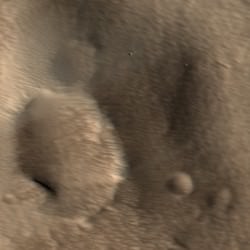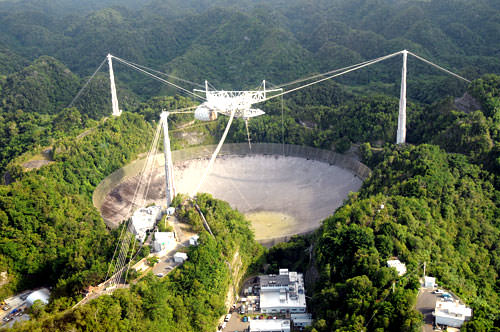A radar map of Mars’ major volcanic regions created by the Arecibo Observatory in Puerto Rico (John Harmon et al., NAIC)
Even though we currently have several missions exploring Mars both from orbit and on the ground, there’s no reason that robots should be having all the fun; recently a team of radio astronomers aimed the enormous 305-meter dish at Puerto Rico’s Arecibo Observatory at Mars, creating radar maps of the Red Planet’s volcanic regions and capturing a surprising level of detail for Earth-based observations.
The team, led by John Harmon of the National Astronomy and Ionosphere Center, bounced radar waves off Mars from Arecibo’s incredibly-sensitive dish, targeting the volcanic Tharsis, Elysium, and Amazonis regions. Depolarized radar imagery best reveals surface textures; the rougher and less uniform a surface is, the brighter it appears to radar while smooth, flat surfaces appear dark.
What the radar maps portray are very bright — and therefore rough — areas on most of the major volcanoes, although some regions do appear dark, such as the summit of Pavonis Mons.
 This likely indicates a covering by smoother, softer material, such as dust or soil. This is actually in line with previous observations of the summit of Pavonis Mons made with the HiRISE camera aboard NASA’s Mars Reconnaissance Orbiter, which showed the summit to appear curiously soft-edged and “out-of-focus”, creating a blurry optical illusion of sorts.
This likely indicates a covering by smoother, softer material, such as dust or soil. This is actually in line with previous observations of the summit of Pavonis Mons made with the HiRISE camera aboard NASA’s Mars Reconnaissance Orbiter, which showed the summit to appear curiously soft-edged and “out-of-focus”, creating a blurry optical illusion of sorts.
It’s thought that the effect is the result of the build-up of dust over millennia, carried across the planet by dust storms but remaining in place once settled because the Martian wind is just so extremely thin — especially at higher altitudes.
The team also found bright areas located away from the volcanoes, indicating rough flows elsewhere, while some smaller volcanoes appeared entirely dark — again, indicating a possible coating of smooth material like dust or solidified lava flows.
The resolution of the radar maps corresponds to the wavelength of the signals emitted from Arecibo; the 12.6 centimeter signal allows for surface resolution of Mars of about 3 km.
The team’s paper was published in the journal Icarus on July 25. Read more on the Red Planet Report here.
The iconic 305-meter radar telescope at Arecibo Observatory in Puerto Rico



Please, could the author of the article read the quoted research paper a bit more carefully. There is not enough velocity (orbital and rotation combined) difference to accomplish a radar signal wavelength shift from S-band microwave to LF-band radio!
The quoted image resolution is indeed related to the doppler shift of the radar signal due to the rotation of the Mars, but the exact relation is significantly more complicated than simple wavelength shift from 12,5cm to 3km. That would require some relativistic velocities!
The quoted paper is fascinating read and I recommend it if it is accessible freely (I’m working at a university so I was able to read it). They have images showing data across the so-called doppler equator, yet they acknowledge that the radar imaging has ambiguity in north-south direction. Overly simplified, the ambiguity in radar imaging stems from the fact that the velocity of the Mars’s ground, when viewed from the Earth, is equal in equal latitudes in south and north. Of course, the tilt of the Mars’s rotation axis and things like that complicate this simple case. How do they get data across this doppler equator is beyond me. (Maybe some of the cited papers might help, but I’ve already used up my today’s non-thesis-writing-time-quota. 😀 )
Are there any radar astronomy experts around here to clarify this?
ps. See for yourselves! The doppler equator is visible in the topmost image of this article. It is a dark horizontal line at -10 degrees latitude. Indeed most of the image data is north from that line, but there are still recognizable features south of the line.
The wavelength did not change significantly from 12.6 cm. The limit of resolution on Mars is determined by the wavelength, the diameter of the Arecibo telescope, and the distance to Mars. Wikipedia has a good page if you search “radio telescope resolution”.
Thanks; I suppose radio telescopes wouldn’t be very useful for deep-sky astronomy if the signals degraded that much.
Nope, paywall.
But this article on doppler imaging hints that the N-S ambiguity can be broken by the reflex delay when the orbiting body’s axis is tilted with respect to the observer. I.e. the relative polar regions (from the observer’s viewpoint) of a spherical body are further away and adds delay.